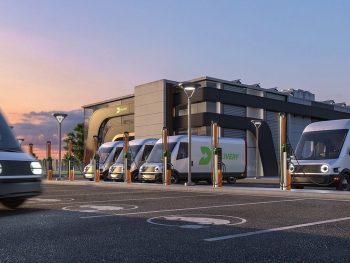The road ahead: Key factors of fleet electrification in 2023
By Frederic Wagner, manager, EV fleet partnerships at ChargePoint
The ease of adoption of EVs should get smoother
With increasing environmental pressures, government policies and mission controls, the trajectory for electric vehicles and the supply chain should become easier. This is especially true in Europe. While there may still be bottlenecks in areas such as vehicle battery capacity and power electronics supply chains, these challenges should be manageable with the increasing demand for electric vehicles.
Lithium-ion batteries have dropped significantly in price
Lithium-ion technology is critical to the advancement of EVs. Mass production of this battery technology has led to significant price reductions in the past 15 years. From a start of almost $1,400 per kWh (adjusted to today’s $ value) in 2008, costs have fallen by 90%, to an average of $153 in 2022. Whilst this means that the battery cost for a heavy-duty truck of hundreds of kWh is substantial, it is far more affordable than it was even a few years ago. Lithium-ion technology should continue to improve by 1.5 to 3% each year. Larger cost reductions could soon be realised as new technologies, such as solid-state batteries, come into mass production, though this could still be a decade away.
Current high energy prices are transient
The current high energy prices are not a permanent issue. Renewable electricity, in the long run, should be much cheaper and will have a much lower impact on the environment than fossil fuels. The energy crisis is a transient event due to recent global instability, and over a 25-year period, we will solve many problems, including the intermittency of renewables and energy storage.
Fleets will help stabilise the grid
While it’s true that they require a high amount of energy from the grid, electric fleets are about to play a central role in energy stability. How? In short, with delivery vehicles doubling as energy storage and fleet depots becoming power generators.
Warehouses often have a lot of space above parking lots. And hall roofs have ample space for solar panels. Furthermore, in the future, V2G vehicles will be used as buffer energy storage. This means the electricity does not have to be fed directly into the grid but remains in the fleet for the time being until needed. Whatever the approach, tackling grid pressure should soon be easier — and electric fleets will play a central role in this mitigation.
The total cost of ownership will still be lower for electric fleet vehicles
Despite the current energy crisis, the long-term total cost of ownership (TCO) for electric fleet vehicles will still be lower compared to internal combustion engines (ICEs). The TCO calculation, based on the average lifespan of vehicles, clearly shows that electrification is the cheaper option.
New fleet segments will electrify
The speed at which fleets will electrify depends on how quickly OEMs ramp up the production of different vehicle classes. Various logistics fleet segments will electrify once there is a plethora of heavy-duty EVs available. Similarly, the last-mile sector will electrify as electric van supply increases, and we can see this happening with companies such as Amazon worldwide and Picnic in Europe.
Some businesses will feel the pressure to electrify quicker than they may have initially planned. Businesses operating in and around urban centres that have adopted low- and zero-emission zones have no choice but to adopt electric vehicles. As such, transitioning their fleets is not only about cost savings or future proofing, but ensuring the continuity of their business. This will most impact fleets in the service, logistics and rental sectors, but should help stand as a beacon to other fleets showing how quickly and easily the transition can be made.
Fleet electrification is a critical part of the solution to the energy crisis and, as OEMs ramp up production, more and more fleet operators are going to make the switch. From battery technology to total cost of ownership, there are several key factors that fleet operators need to consider as they look to electrify their fleets. Despite the current challenges, the trajectory for electric vehicles is expected to become smooth, and the future of the fleet industry looks set to be electric.








